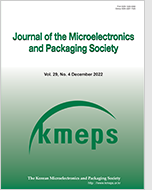
Search
- Past Issues
- e-Submission
-

KCI Accredited Journals KCI 등재지
KCI Impact Factor 0.54
Editorial Office
- +82-2-538-0962
- +82-2-538-0963
- kmeps@kmeps.or.kr
- http://kmeps.or.kr/

KCI Accredited Journals KCI 등재지
KCI Impact Factor 0.54
Journal of the Microelectronics and Packaging Society 2024;31(4):83-88. Published online: Jan, 22, 2025
DOI : doi.org/10.6117/kmeps.2024.31.4.083
In this research, Fe-Ni alloy films were electroplated in the cell with different anode, DSA (inert anode) and Ni (soluble anode) to investigate the effect of anode type on the deposits and the baths. The deposits obtained from the Ni anode had higher Ni content than those from the DSA due to the increase in Ni2+ concentration of the baths, caused by Ni anode dissolution. The potential monitoring showed that the oxidation of Fe2+ to Fe3+ was the only reaction of DSA at the current density where Fe-Ni electroplating was conducted. Fe3+ formed at the DSA not only caused decrease in pH but increase in OCP of the baths. On the other hand, the pH and OCP of the bath using Ni anode changed slightly because the anodic potential during electroplating was insufficient to oxidize Fe2+ and form Fe3+.
Keywords Fe-Ni alloy, Electrodeposition, Inert anode, Soluble anode